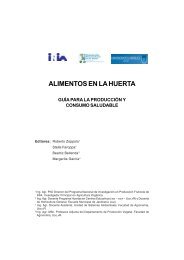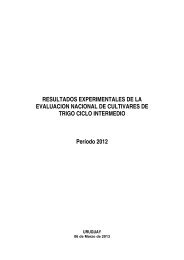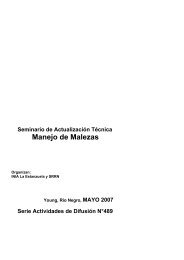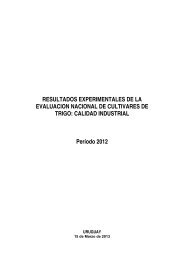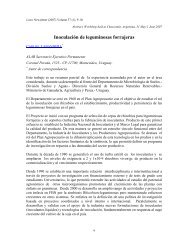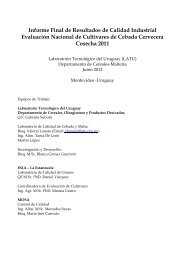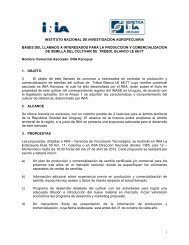Use of Lotus/Rhizobium Symbiosis in Regeneration of Polluted ... - Inia
Use of Lotus/Rhizobium Symbiosis in Regeneration of Polluted ... - Inia
Use of Lotus/Rhizobium Symbiosis in Regeneration of Polluted ... - Inia
Create successful ePaper yourself
Turn your PDF publications into a flip-book with our unique Google optimized e-Paper software.
<strong>Lotus</strong> Newsletter (2007) Volume 37 (2), 87 – 88.<br />
Abstract, Workshop held at Valencia, 6-7 September 2007<br />
<strong>Use</strong> <strong>of</strong> <strong>Lotus</strong>/<strong>Rhizobium</strong> <strong>Symbiosis</strong> <strong>in</strong> <strong>Regeneration</strong> <strong>of</strong> <strong>Polluted</strong><br />
Soils<br />
ISABEL VIDEIRA E CASTRO* 1 , PAULA SÁ-PEREIRA 2 , FERNANDA SIMÕES 2 , JOSÉ A.<br />
MATOS 2 and EUGÉNIO FERREIRA 1<br />
1 Dep. Ecologia, Recursos Naturais e Ambiente, Laboratório de Microbiologia, INRB, Av. da<br />
República, Nova Oeiras, 2780-159 Oeiras, Portugal<br />
2 Dep. Biotecnologia, Grupo de Biologia Molecular, INETI, Estrada do Paço do Lumiar, 22,<br />
1649-038 Lisboa, Portugal<br />
* Correspond<strong>in</strong>g author click here for Portuguese version<br />
In polluted soils the presence <strong>of</strong> toxic <strong>in</strong>organic compounds such as heavy metals has an<br />
important impact on the resident micr<strong>of</strong>lora, which seems to be much less varied <strong>in</strong> polluted<br />
areas. In last years, our group has been <strong>in</strong>volved <strong>in</strong> projects aimed to evaluate the harmful<br />
effects <strong>of</strong> long term heavy metals contam<strong>in</strong>ation <strong>of</strong> soils on the <strong>Rhizobium</strong>-legume<br />
symbiosis, ma<strong>in</strong>ly those ones with R. legum<strong>in</strong>osarum bv. trifolii and Trifolium sp. (Castro et<br />
al., 1997; 2003). An important activity for regeneration soils polluted by <strong>in</strong>dustrial activities<br />
is the establishment <strong>of</strong> vegetation. Legum<strong>in</strong>ous plants can have, here, an important role due<br />
their <strong>in</strong>terest<strong>in</strong>g agricultural potential, their capacity to fix atmospheric nitrogen and<br />
adaptation to low <strong>in</strong>put agricultural systems. Particularly <strong>in</strong> the case <strong>of</strong> <strong>Lotus</strong> species, some<br />
<strong>of</strong> them are present <strong>in</strong> rather extreme conditions such as those exist<strong>in</strong>g <strong>in</strong> contam<strong>in</strong>ated soils.<br />
The aim <strong>of</strong> this work was to exam<strong>in</strong>e the effects <strong>of</strong> soil pollution on the genetic and<br />
phenotypic characteristics <strong>of</strong> rhizobial population isolated from <strong>Lotus</strong> sp. grow<strong>in</strong>g <strong>in</strong><br />
contam<strong>in</strong>ated soils (ma<strong>in</strong>ly with Hg and As). The soils were selected from an <strong>in</strong>dustrial area<br />
with known environmental pollution problems, where heavy metals and other pollutants<br />
have been emitted for nearly 40 years. This area is particularly affected by the release <strong>of</strong><br />
liquid effluents from fertilizer and chemical <strong>in</strong>dustries. Tak<strong>in</strong>g <strong>in</strong> account that symbiotic<br />
<strong>in</strong>teractions between species <strong>of</strong> the genus <strong>Lotus</strong> and <strong>Rhizobium</strong> stra<strong>in</strong>s can be effective,<br />
<strong>in</strong>effective or parasitic accord<strong>in</strong>g with to comb<strong>in</strong>ation, nodulation tests were evaluated with<br />
different lotus species. Several parameters were also analysed such as population size,<br />
nitrogen fixation capacity, genetic diversity and mercury and arsenic tolerance. The results<br />
suggested that some <strong>of</strong> the <strong>Lotus</strong>/<strong>Rhizobium</strong> symbioses seem to be particularly well adapted<br />
to adverse environmental conditions and can be an adequate tool for bioremediation <strong>of</strong><br />
polluted soils.<br />
References<br />
CASTRO I.V., FERREIRA E.M. and MCGRATH S.P. 1997. Effectiveness and genetic diversity<br />
<strong>of</strong> <strong>Rhizobium</strong> legum<strong>in</strong>osarum bv. trifolii isolates <strong>in</strong> portuguese soils polluted by<br />
<strong>in</strong>dustrial effluents. Soil Biology & Biochemistry, 29, 1209-1213.<br />
87
88 I. Videira E Castro, P. Sá-Pereira, F. Simões, J.A. Matos and E. Ferreira<br />
CASTRO I.V., FERREIRA E.M. and MCGRATH S.P. 2003. Survival and plasmid stability <strong>of</strong><br />
rhizobia <strong>in</strong>troduced <strong>in</strong>to a contam<strong>in</strong>ated soil. Soil Biology and Biochemistry, 35, 49-54.<br />
This work was supported by FCT, POCTI (AGG/4607/2002) and FEDER



